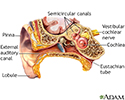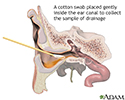Ear drainage culture
Culture - ear drainage
An ear drainage culture is a lab test. This test checks for germs that can cause infection. The sample taken for this test can contain fluid, pus, wax, or blood from the ear.
How the Test is Performed
A sample of ear drainage is needed. Your health care provider will use a cotton swab to collect the sample from inside the outer ear canal. In some cases, a sample is collected from the middle ear during ear surgery.
The sample is sent to a lab and placed on a special dish (culture media).
The lab team checks the dish every day to see if bacteria, fungi, or viruses have grown. More tests may be done to look for specific germs and determine the best treatment.
How to Prepare for the Test
You do not need to prepare for this test.
How the Test will Feel
Using a cotton swab to take a sample of drainage from the outer ear is not painful. However, ear pain may be present if the ear is infected.
Ear pain
An earache is a sharp, dull, or burning pain in one or both ears. The pain may last a short time or be ongoing. Related conditions include:Otitis m...

Ear surgery is done using general anesthesia. You will be asleep and feel no pain.
Ear surgery
Ear tube insertion involves placing tubes through the eardrums. The eardrum is the thin layer of tissue that separates the outer and middle ear. ...

Why the Test is Performed
The test may be done if you or your child has:
- An ear infection that is not getting better with treatment
-
An infection of the outer ear (
otitis externa
)
Otitis externa
Swimmer's ear is inflammation, irritation, or infection of the outer ear and ear canal. The medical term for swimmer's ear is otitis externa. Swimme...
 ImageRead Article Now Book Mark Article
ImageRead Article Now Book Mark Article - An ear infection with a ruptured eardrum and draining fluid
It may also be done as a routine part of myringotomy .
Myringotomy
Ear tube insertion involves placing tubes through the eardrums. The eardrum is the thin layer of tissue that separates the outer and middle ear. ...

Note: Ear infections are diagnosed based on symptoms rather than using a culture.
Normal Results
The test is normal if there is no growth on the culture.
Note: Normal value ranges may vary slightly among different laboratories. Talk to your provider about the meaning of your specific test results.
What Abnormal Results Mean
Abnormal results may be a sign of an infection. The infection can be caused by bacteria, virus, or fungus.
The test results may show which organism is causing the infection. It will help your provider decide on the right treatment.
Risks
No risks are involved with swabbing the ear canal. Ear surgery may involve some risks.
Ear surgery
Ear tube insertion involves placing tubes through the eardrums. The eardrum is the thin layer of tissue that separates the outer and middle ear. ...

References
Bauer CA, Jenkins HA. Otologic symptoms and syndromes. In: Flint PW, Haughey BH, Lund V, et al, eds. Cummings Otolaryngology . 6th ed. Philadelphia, PA: Elsevier Saunders; 2015:chap 156.
Murray PR. The clinician and the microbiology laboratory. In: Bennett JE, Dolin R, Blaser MJ, eds. Mandell, Douglas, and Bennett's Principles and Practice of Infectious Diseases, Updated Edition . 8th ed. Philadelphia, PA: Elsevier Saunders; 2015:chap 16.
-
Ear anatomy - illustration
The ear consists of external, middle, and inner structures. The eardrum and the 3 tiny bones conduct sound from the eardrum to the cochlea.
Ear anatomy
illustration
-
Medical findings based on ear anatomy - illustration
The external structures of the ear may aid in diagnosing some conditions by the presence or absence of normal landmarks and abnormal features including: earlobe creases, preauricular pits, and preauricular tags.
Medical findings based on ear anatomy
illustration
-
Ear drainage culture - illustration
An ear drainage culture is collected by placing a cotton swab gently in the ear canal. The sample is sent to the laboratory for testing to isolate and identify the type of organism causing the ear infection.
Ear drainage culture
illustration
-
Ear anatomy - illustration
The ear consists of external, middle, and inner structures. The eardrum and the 3 tiny bones conduct sound from the eardrum to the cochlea.
Ear anatomy
illustration
-
Medical findings based on ear anatomy - illustration
The external structures of the ear may aid in diagnosing some conditions by the presence or absence of normal landmarks and abnormal features including: earlobe creases, preauricular pits, and preauricular tags.
Medical findings based on ear anatomy
illustration
-
Ear drainage culture - illustration
An ear drainage culture is collected by placing a cotton swab gently in the ear canal. The sample is sent to the laboratory for testing to isolate and identify the type of organism causing the ear infection.
Ear drainage culture
illustration
Review Date: 8/31/2016
Reviewed By: Neil K. Kaneshiro, MD, MHA, Clinical Assistant Professor of Pediatrics, University of Washington School of Medicine, Seattle, WA. Also reviewed by David Zieve, MD, MHA, Isla Ogilvie, PhD, and the A.D.A.M. Editorial team.



